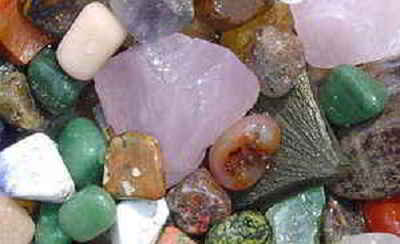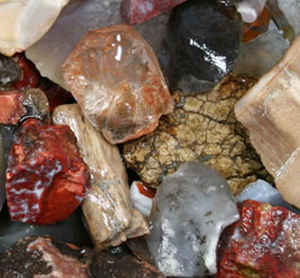
Tennessee Symbols
Tennessee State Rock
Limestone

(Calcium carbonate)
Adopted on March 13, 1979
Limestone, Calcium carbonate, found just about everywhere in Tennessee, was declared the official state rock in 1979. Limestone is most abundant through middle Tennessee and is found in scattered areas through eastern Tennessee. Tennessee marble, as the metamorphic version of limestone is known, is widely used in public and private buildings. In 1969, the General Assembly had given similar status to agate, a cryptocrystalline quartz.
Tennessee State Rock: Limestone

Tennessee marble, as the metamorphic version of limestone is known, is widely used in public and private buildings. In 1969, the General Assembly had given similar status to agate, a cryptocrystalline quartz. This semiprecious gemstone is found only in a few areas of the state. Tennessee marble, as the metamorphic version of limestone is known, is widely used in public and private buildings.
In the building stone industry, any high-quality, hard limestone may be called marble, even if it hasn't metamorphosed to marble. Tennessee's commercial marbles are actually limestones of this type: massive, crystalline, and dense. They occur in beds and lenses within the Holston Formation in the Valley and Ridge physiographic province of eastern Tennessee, a narrow band of folded rocks that date from the Ordovician period (500-440 million years ago). These rocks started out as sediments in shallow seas, over a continental shelf. They come in a variety of colors, from off-white to dark red.
Limestone is a sedimentary rocks made up of layers of silt, small pieces of other rocks, and sometimes the skeletons of tiny creatures. In the middle
of the Ordovician period, the first coral reefs appeared. Reefs existed earlier, during the Cambrian, but they were built by sponges and other organisms.
The corals joined pre-existing groups of invertebrates, including trilobites, bivalve mollusks (similar to clams and oysters), snails, and cephalopods
(mollusks related to today's nautilus, cuttlefish, octopus, and squid). Brachiopods were also abundant and diverse. Brachiopods have bivalve shells,
but are not mollusks. The two halves of their shells are not symmetrical. They persist today, but are rare. Most died out during a mass extinction
at the end of the Permian period (230 million years ago), when the shallow seas that had covered much of the continents began to retreat. The first
fishes had just begun to appear in the Ordovician, but would not dominate the seas until the Silurian and Devonian periods.
In Tennessee, and in much of eastern North America, calcium carbonate sediment accumulated in the warm, shallow continental seas and eventually compacted
into limestone. Then, around 300 million years ago, the continents began to converge into the supercontinent Pangaea. The force of the long, slow collision
between Africa and North America buckled most of eastern North America into a long, folded ridge, the Appalachians. The Ordovician limestones in eastern
Tennessee were pushed into long, narrow, northeast-southwest folds.
Tennessee marble quarrying began in 1838, with a quarry near Rogersville in Hawkins County. Most of the quarries are in the Knoxville area. Tennessee
marble is still being quarried and is used for statues, buildings, grave markers, and crushed stone. It is also part of the Lincoln Memorial, Grand
Central Station in New York, and the Tennessee State Capitol, among many other buildings and monuments.
There are three basic types of rocks: sedimentary, igneous, and metamorphic.
- Sedimentary rocks are made up of layers of silt, small pieces of other rocks, and sometimes the skeletons of tiny creatures. One example of a sedimentary rock is the chalk you use at school. Another example is limestone, one of Tennessee's state rocks. The rocks you see inside caves are made of limestone. The Grand Canyon is made up of sandstone, limestone, and shale that have been eroded by the Colorado River to form the Canyon as it is today.
- Igneous rocks started as molten magma or lava and then cooled to become rock. Coarse grained rocks are formed when the lava cools slowly and fine grained rocks from when it cools faster. Some examples of igneous rocks are granite and peridotite. The Hawaiian islands are made of cooled volcanic lava called basalt. One of the most popular igneous rocks is an Apache Tear.
- Metamorphic rocks are rocks that have been changed by heat or pressure while forming. Sedimentary and igneous rocks can become metamorphic rock. Slate is used in blackboards, talc in talcum power, and soapstone for carving.
PHYSICAL CHARACTERISTICS:

Limestone is a sedimentary rock composed
largely of the minerals calcite and aragonite, which are different crystal forms of calcium carbonate (CaCO3). Most limestone is composed of skeletal
fragments of marine organisms such as coral or foraminifera.
Limestone makes up about 10% of the total volume of all sedimentary rocks. The solubility of limestone in water and weak acid solutions leads to karst
landscapes, in which water erodes the limestone over thousands to millions of years. Most cave systems are through limestone bedrock.
Limestone has numerous uses: as a building material, as aggregate for the base of roads, as white pigment or filler in products such as toothpaste
or paints, and as a chemical feedstock.
The first geologist to distinguish limestone from dolomite was Belsazar Hacquet in 1778.
- Color is extremely variable but generally white or colorless or with light shades of yellow, orange, blue, pink, red, brown, green, black and gray. Occasionally iridescent.
- Luster is vitreous to resinous to dull in massive forms.
- Transparency: Crystals are transparent to translucent.
- Crystal System is trigonal; bar 3 2/m
- Crystal Habits are extremely variable with almost any trigonal form possible. Common among calcite crystals are the scalenohedron, rhombohedron, hexagonal prism, and pinacoid. Combinations of these and over three hundred other forms can make a multitude of crystal shapes, but always trigonal or pseudo-hexagonal. Twinning is often seen and results in crystals with blocky chevrons, right angled prisms, heart shapes or dipyramidal shapes. A notch in the middle of a doubly terminated scalenohedron is a sure sign of a twinned crystal. lamellar twinning also seen resulting in striated cleavage surfaces.
- Pseudomorphs after many minerals are known, but easily identified as calcite. Also massive, fibrous, concretionary, stalactitic,
nodular, oolitic, stellate, dendritic, granular, layered, etc. etc.
Cleavage is perfect in three directions, forming rhombohedrons. - Fracture is conchoidal.
- Hardness is 3 (only on the basal pinacoidal faces, calcite has a hardness of less than 2.5 and can be scratched by a fingernail).
- Specific Gravity is approximately 2.7 (average)
- Streak is white.
- Other Characteristics: refractive indices of 1.49 and 1.66 causing a significant double refraction effect (when a clear crystal is placed on a single line, two lines can then be observed), effervesces easily with dilute acids and may be fluorescent, phosphorescent, thermoluminescence and triboluminescent.
- Associated Minerals are numerous but include these classic associations: Fluorite, quartz, barite, sphalerite, galena, celestite, sulfur, gold, copper, emerald, apatite, biotite, zeolites, several metal sulfides, other carbonates and borates and many other minerals.
- Notable Occurrences include Pugh Quarry, Ohio; Rosiclare, Illinois; Franklin, New Jersey; Elmwood, Tennessee; Brush Creek and other Missouri, Wisconsin, Kansas and Oklahoma localities, USA; Andreasburg, Harz Mountains and Saxony, Germany; Brazil; Guanajuato, Mexico; Cornwall, Durham and Lancashire, England; Bombay area of India; Eskifjord, Iceland; many African localities as well as others around the world with their own unique varieties.
- Best Field Indicators are crystal habit, reaction to acid, abundance, hardness, double refraction and especially cleavage.
Tennessee Law
The law designating calcium carbonate, commonly known as limestone as the official Tennessee state rock is found in the Tennessee Code Annotated, title 4, chapter 1, part 3, section 4 -1-309
Title 4 State Government
Chapter 1 General Provisions
Part 3 State Symbols
Tenn. Code Ann. § 4-1-309 (2011)
4-1-309. State rock.
The useful and attractive calcium carbonate, commonly known as limestone, is hereby designated as the official state rock.
HISTORY: Acts 1979, ch. 42, § 1; T.C.A., § 4-128.
Minerals, & Gems

Gemstone, Minerals, Rocks






